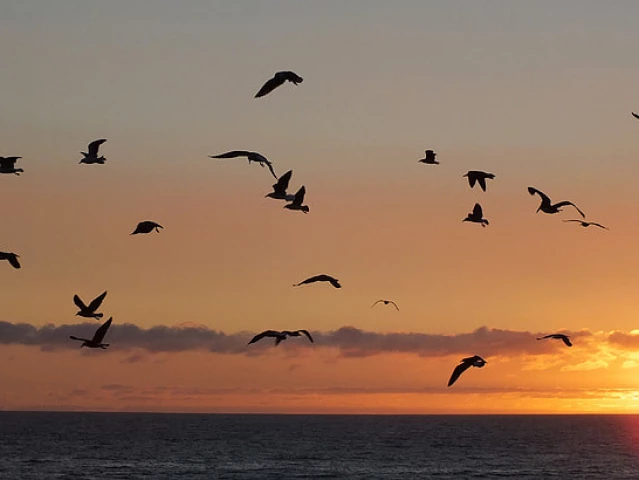Urbanisation is a 'bird-en' that Karachi can not sustain much longer
Native birds populations are decreasing by the day

Karachi was once described as one of the world’s great coastal metropolises, a city where nearly a hundred species of native birds could be found. Kingfishers perched near mangroves, sparrows flocked in backyards, and herons moved gracefully across wetlands. For older residents, these sightings were unremarkable, part of the city’s natural rhythm.
But today, they are becoming rare and the reasons reach deep into the city’s changing landscape. The first factor, experts say, is habitat loss. “Removal of trees and natural nesting habitats forces native birds to vacate urban areas,” said Rafi ul Haq, former national coordinator at the International Union for Conservation of Nature (IUCN) while speaking to The Express Tribune. A plant ecologist with decades of experience, he recalled how guava and mango trees once housed parrots and quails. “Deforestation has left these birds without the habitat they need for shelter, food, and laying eggs.”
Shifts in weather patterns have further deepened the strain. “Changing climate and weather patterns as well as destruction of natural habitat disturb the balance that is needed for birds to survive and reproduce,” said Dr. Harish, avian specialist and veterinarian at the Animals and Birds Care Center. For many species, even small disruptions to temperature or rainfall cycles can interfere with breeding.
Others emphasise the role of food sources. “All bird species rely on a specific habitat for their survival, which includes trees and a specific diet such as fruits, seeds, or insects,” said Shahzad Qureshi, founder of Urban Forest. “If that habitat is destroyed, there is no place for the birds to nest and no food for them to eat.” The result is an unraveling of natural systems. “Flora and fauna are often dependent on one another for survival. If any piece in this puzzle is removed, the whole ecosystem may be lost,” Qureshi added.
According to the WWF, even common species are now in decline. Sparrows, once abundant, are rapidly decreasing, while songbirds such as mynas, larks, and bulbuls are disappearing from urban areas. At the same time, scavengers like crows and kites are multiplying. The trend extends across bird families. “Other species at risk include passerine birds like munias and tailorbirds, wading birds such as herons, egrets, stilts, and sandpipers, and raptors like kites, falcons, owls, and other birds of prey,” said Zohaib Ahmed, project manager at Re-Wilding Indus and a wildlife photographer. “All of these groups are seeing declining numbers due to shrinking habitats, reduced food availability, and human disturbance.” Predation by dominant species compounds the problem. “The high population of house crows in Karachi is one of the biggest threats to smaller native birds,” said Zohaib. “Crows raid nests for eggs and chicks, targeting species such as the house sparrow, common tailorbird, white-throated munia, and white-browed fantail. They are also capable of hunting more human-friendly birds like swifts, martins, and swallows.”
Sparrows, too small to defend themselves, are particularly vulnerable. “Overpopulation of certain bird species has resulted in a more competitive ecosystem,” said Rafi. “The large number of kites and crows have made it very hard for other native bird species to thrive.” Humans can contribute heavily to these imbalances, too. “Places like Kabootar Chowk cause an influx of overly large amounts of one type of bird, which then makes it harder for other species to grow their populations,” Rafi said. “People throw leftover meat parts for eagles and crows, which increases the risk of bacterial infection outbreaks among birds.”
These scraps also draw other predators. “Stray dogs and cats feed on the leftovers but also prey on eggs of ground-nesting birds like lapwings,” Zohaib said. Garbage piles provide further fuel for crows and kites, strengthening their dominance in the urban environment. “Their ability to feed on garbage and survive in human-modified habitats allows them to thrive while native species disappear.”
Evidence from outside Karachi suggests similar dynamics. A study conducted in Sargodha between November 2010 and March 2011 recorded 2,998 house sparrows and 2,619 house crows in rural areas, but in urban areas crows outnumbered sparrows – 2,056 to 1,873. Researchers noted that such patterns point to competition and other stressors shaping sparrow decline.
Experts then agree that reversing these trends requires urgent intervention. “Citizens can create bird-friendly spaces at home, in schools, and in neighborhoods,” Zohaib said. “Place nest boxes, provide safe water sources, avoid littering, and participate in clean-up drives in wetlands and green belts.”
Government measures are equally important. “Authorities must protect and restore natural habitats such as wetlands, green belts, and mangroves, design urban wildlife-friendly parks, and use graveyards and open lands as green sanctuaries. Wildlife patrolling to prevent poaching, and empowering police and park authorities to act against illegal wildlife trade, especially in markets like Empress Market, are vital.” said Zohaib.
Lastly, reforestation offers the most sustainable fix. “Habitat restoration is the most crucial factor,” said Qureshi. “Reforestation should not mean planting just one tree type, but several native species. Different trees are home to different birds, and only an equilibrium of all kinds will restore diversity. Dense canopies are particularly important because they allow for secure nesting.”
The warnings could not be clearer. Karachi’s birdlife once gave the city its colour and song. Without immediate action to restore habitats and rebalance ecosystems, these sounds may vanish altogether.




















COMMENTS
Comments are moderated and generally will be posted if they are on-topic and not abusive.
For more information, please see our Comments FAQ